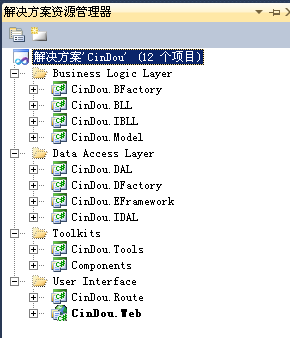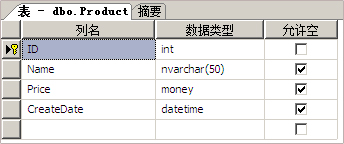|
介于这段时间的学习,MVC 和 Entity Framework 再加上自己对框架这部分的理解,弄了这么个Demo,希望大家能给点意见,一起讨论讨论。本章中没有多么高深的理论知识,只是个人对于架构的理解,加上MVC
和 EntityFramework,可以说是个整体的部分
先贴下我的项目的分布图:

整个项目主要采用三层架构,面向接口的编程方式。
界面层:User Interface
CinDou.Web主要放我们的Web页面,
CinDou.Route主要放置MVC中Controller,
这里我采用把Controller分离出来。个人考虑的原因是:项目比较清晰,职责比较单一。
逻辑层:Business Logic Layer
CinDou.BFactory 是逻辑工厂层,用于创建逻辑层的接口,便于界面层调用。
CinDou.IBLL 逻辑接口层
CinDou.BLL 逻辑业务层 主要负责逻辑层中的业务。
CinDou.Model 逻辑业务类
数据库层:Data Accss Layer
CinDou.DFacoty:数据工厂层,用于创建数据库层的接口,从而让逻辑层调用
CinDou.IDAL : 数据库接口层
CinDou.DAL : 数据库持久层
CinDou.EFramework: Entity Framework层
工具层:ToolKit
CinDou.Tools 常用的工具类方法层
Component :控件层
大概的一个分层是这个样子的。其实园子里有很多同学都说过这个话题,每个人对分层有各自的看法,不过看了很多文章,总感觉有点语曰不详,或者可能是我没有找到,所以个人自己写个,希望有兴趣的同学们一起讨论下。
貌似MVC现在比较热闹,所以,在这个项目中我也采取了MVC,但是MVC的Controller总是包含在站点文件夹中,这个总让我很不爽,至于为什么不爽,个人总感觉Controller是个页面的逻辑部分,一般在以前我们总放在aspx.cs文件中,但是mvc没有这个aspx.cs文件,所以,索性我们把这部分单独出来建立了CinDou.Route这个项目

为了使这个Controller能单独出来,我们必须还要做一些其它的工作:
Step1:在CinDou.Tools中建立
IRegisterRoutes.cs
|
using System.Web.Routing;
namespace CinDou.Tools
{
interface IRegisterRoutes
{
void RegisterRoutes(RouteCollection Routes);
}
} |
CinDouRoutes.cs
|
using System.Web.Routing;
using System.Web.Mvc;
namespace CinDou.Tools
{
class CinDouRoutes : IRegisterRoutes
{
public void RegisterRoutes(RouteCollection routes)
{
routes.IgnoreRoute("{resource}.axd/{*pathInfo}");
routes.MapRoute(
"Default", // Route name
"{controller}/{action}/{id}", // URL with parameters
new { controller = "Home", action = "Index", id = UrlParameter.Optional } // Parameter defaults
);
}
}
} |
CinDouApplication.cs
|
using System.Web;
using System.Web.Mvc;
using System.Web.Routing;
namespace CinDou.Tools
{
public class CinDouApplication : HttpApplication
{
protected void Application_Start()
{
CinDouRoutes pdr = new CinDouRoutes();
AreaRegistration.RegisterAllAreas();
pdr.RegisterRoutes(RouteTable.Routes);
}
}
} |
我们在CinDou.Tools中建立好这三个文件后,然后在CinDou.Web中引用这个Dll即可。
同时,我们修改Global.asax文件使其指向我们刚刚建立的CinDouApplication文件。右键点击Global.asax文件,点"查看标记”然后修改为:
<%@ Application Inherits="CinDou.Tools.CinDouApplication"
Language="C#" %>
我们在CinDou.Route中创建创建的ProductController就能起作用了~
|
using System.Web.Routing;
namespace CinDou.Tools
{
interface IRegisterRoutes
{
void RegisterRoutes(RouteCollection Routes);
}
} |
发了前面两篇文章后,有的同学说:“分层应该依项目而定,没有什么最好的分层,只有最合适的。” 也有同学说
“分层太复杂,才多大的项目”
在这里我想发表下我的看法,个人之言,权当讨论的话题:首先说分层应该依项目而定,这话总体来说没有错误,但是到底什么样的项目该用什么样的分层
这个没有定数,至少我还不知道这个确切的分界线~况且,我们现在可能做个小项目,到以后也许慢慢发展起来怎么办?
对于这个分层是否过于复杂,个人并不是这么看的,至少这么分层,每个分层都有其中不可少的因素在里面。前期搭建好以后,也许项目真的发展起来后,
会有助于项目真正的开发。当然,如果是小项目,个人也觉得没有必要分太多层。
好了,现在说说,我们这个EF的底层框架怎么搭建。
首先 我们现在数据库建一个表 Product 表结构如下:

在CinDou.EFramework层中建立 CinDouDbContext.cs 文件,代码如下
|
using System.Data.Entity;
using System.Data.Entity.Infrastructure;
using System.Data.Entity.ModelConfiguration.Conventions;
using CinDou.Tools;
using CinDou.Model;
namespace CinDou.EFramework
{
string connection="xxxxx"; //数据库链接
public class CinDouDbContext : DbContext
{
public AppedDbContext()
: base(connection)
{ }
public DbSet<Product> Products{get; set;}
protected override void OnModelCreating(DbModelBuilder modelBuilder)
{
modelBuilder.Conventions.Remove<PluralizingTableNameConvention>();//移除复数表名的契约
modelBuilder.Conventions.Remove<IncludeMetadataConvention>();
//防止黑幕交易 要不然每次都要访问 EdmMetadata这个表
}
}
} |
在 CinDou.Model 项目中建立 Product.cs
|
using System;
using System.Collections.Generic;
using System.Linq;
using System.Text;
using System.ComponentModel.DataAnnotations;
namespace CinDou.Model
{
public class Product
{
public int ID { get; set; }
[Column("Name")]
public string ProductName { get; set; }
[Column("Price")]
public decimal ProductPrice { get; set; }
public DateTime CreateDate { get; set; }
}
} |
在BFactoy和DFactory层中分别建立BLLFactory。cs 和 DALFactory.cs
|
using System;
using System.Collections.Generic;
using System.Reflection;
using System.Linq;
using System.Text;
using CinDou.Tools;
using CinDou.IBLL;
using CinDou.BLL;
namespace CinDou.BFactory
{
public sealed class BLLFactory
{
static string bllLayer = WebSite.BLLAssembly;
public static CinDou.IBLL.IProduct CreateProduct()
{
return (CinDou.IBLL.IProduct)Assembly.Load(bllLayer).CreateInstance(bllLayer + ".Product");
}
}
}
using System.Reflection;
using CinDou.Tools;
using CinDou.IDAL;
using CinDou.DAL;
namespace CinDou.DFactory
{
public sealed class DALFactory
{
static string dalLayer = WebSite.DALAssembly;
public static CinDou.IDAL.IProduct CreateProduct()
{
return (CinDou.IDAL.IProduct)Assembly.Load(dalLayer).CreateInstance(dalLayer + ".Product");
}
}
} |
这里,我们使用了反射和工厂模式。这样便于解耦和层的封闭
在CinDou.IBLL和CinDou.IDAL中分别建立IProduct.cs文件
|
using System;
using System.Collections.Generic;
using System.Linq;
using System.Text;
using CinDou.Model;
namespace CinDou.IBLL
{
public interface IProduct
{
bool Add(CinDou.Model.Product product);
IEnumerable<CinDou.Model.Product> List();
}
}
using System;
using System.Collections.Generic;
using System.Linq;
using System.Text;
using CinDou.Model;
namespace CinDou.IDAL
{
public interface IProduct
{
bool Add(Product product);
IEnumerable<Product> List();
}
} |
然后再在CinDou.BLL和CinDou.DAL中建立Product.cs
|
using System;
using System.Collections.Generic;
using System.Linq;
using System.Text;
using CinDou.IBLL;
using CinDou.DFactory;
using CinDou.IDAL;
using CinDou.DAL;
using CinDou.Model;
namespace CinDou.BLL
{
public class Product : CinDou.IBLL.IProduct
{
public bool Add(CinDou.Model.Product product)
{
return CinDou.DFactory.DALFactory.CreateProduct().Add(product);
}
public IEnumerable<CinDou.Model.Product> List()
{
return CinDou.DFactory.DALFactory.CreateProduct().List();
}
}
}
using System;
using System.Collections.Generic;
using System.Linq;
using System.Text;
using System.Data.Entity;
using CinDou.IDAL;
using CinDou.EFramework;
using CinDou.Model;
using CinDou.Tools;
namespace CinDou.DAL
{
public class Product : CinDou.IDAL.IProduct
{
private CinDouDbContext CinDouDB = new CinDouDbContext;
public bool Add(CinDou.Model.Product product)
{
bool flag = false;
try
{
CinDouDB.Products.Add(product);
CinDouDB.SaveChanges();
flag = true;
}
catch{ }
return flag;
}
public IEnumerable<CinDou.Model.Product> List()
{
return CinDouDBProducts.ToList();
}
}
} |
我们再在CinDou.Route项目中建立 Controllers文件夹,然后建立ProductController.cs文件
|
using System;
using System.Collections.Generic;
using System.Linq;
using System.Text;
using System.Web.Mvc;
using CinDou.IBLL;
using CinDou.BFactory;
namespace CinDou.Route.Controllers
{
public class ProductController : Controller
{
public ViewResult Index()
{
return View(CinDou.BFactory.BLLFactory.CreateProduct().List());
}
public ActionResult Create()
{
return View(new CinDou.Model.Product());
}
//
// POST: /Department/Create
[HttpPost]
public ActionResult Create(CinDou.Model.Product product)
{
bool flag = CinDou.BFactory.BLLFactory.CreateProduct().Add(product);
return RedirectToAction("Index");
}
}
} |
在CinDou.Web项目中的Views文件夹下建立Product文件夹,在里面建立Index.cshtml文件
在建立的时候,借助vs的智能感应,能非常方便的建立index.cshtml文件中的内容。
|
@model IEnumerable<CinDou.Model.Product>
<
@Html.ActionLink("Create New", "Create")
</p>
<table>
<tr>
<th>
ProductName
</th>
<th>
ProductPrice
</th>
<th>
CreateDate
</th>
<th></th>
</tr>
@foreach (var item in Model) {
<tr>
<td>
@Html.DisplayFor(modelItem => item.ProductName)
</td>
<td>
@Html.DisplayFor(modelItem => item.ProductPrice)
</td>
<td>
@Html.DisplayFor(modelItem => item.CreateDate)
</td>
<td>
@Html.ActionLink("Edit", "Edit", new { id=item.ID }) |
@Html.ActionLink("Details", "Details", new { id=item.ID }) |
@Html.ActionLink("Delete", "Delete", new { id=item.ID })
</td>
</tr>
}
</table> |
|


